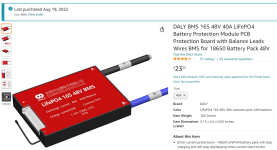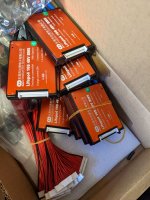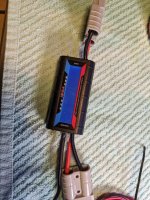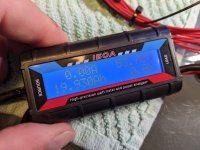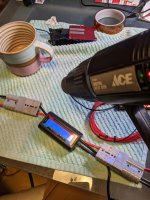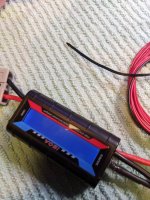Normaly if I get a failure on a device like a BMS, I would not publish it on a forum as it doesn't mean it's a bad product, and could give unfair bad publicity, but in this case I see this problem on 4 Daly BMS that I own, which makes me suspect it is a design issue rather than bad luck or misuse.
Last year I bought 5 Daly BMS from Dalystore at AliE: 2 14S 30A, 1 13S 60A and 2 10S 30A, all with separate charge port. The first time I triggered the LVC on the 13S BMS when my ebike battery was almost empty, it never recovered after stopping bike and trying to switch on display. Back home I measured some strange low voltages on charge- and output-port and my Grin Satiator refused to charge it. I thought it was broken, but removed it from battery and reconnected it again and it was normal again. Since then I have not triggered LVC on that BMS. The same applies to my 10S BMSes. On both the 14S BMS, I have triggered LVC a few times and they never recovered normaly without disconnecting battery, and after a 2-3 LVC even disconnecting did not get them back to normal, and I considered them faulty. I contacted Daly store, and they asked me to check voltage on all balance lines, which I knew was allright and not the cause of the problem. As expected they wouldn't admit that this could be a problem, so I suggested that they send me 2 14S BMS and I would pay for one of them. I selected the Common charge port this time to rule out if this was related to the Separate port design.
Turns out this BMS have the same problem. I have triggered LVC 2 times now (my commute drains my battery on one charge, so it's a bit unavoidable to not trigger LVC sometimes especially in winter), and both times I needed to separate battery and BMS to be able to charge it. Last time voltage was 44V which is above LVC. It hasn't failed so far, but expect it to happen later on as the previous two 14S BMS. Normaly one would expect a BMS to fail if driven too hard, but in this case it fails when current drain is low, probably less than 10A, and at low voltage. Hence it seems that the BMS is left in a logical state thats not healthy for it, and which it cannot recover from on its own.
All this makes me think there is a design weakness in the Daly BMS, and the reason for posting is to get feedback from other Daly BMS users if you have experienced the same or be willing to test it by draining battery to see if it recovers. It could potentially ruin the BMS, but then you know it doesn't work as it should, and we can then address this to Daly and hopefully get it improved.
Last year I bought 5 Daly BMS from Dalystore at AliE: 2 14S 30A, 1 13S 60A and 2 10S 30A, all with separate charge port. The first time I triggered the LVC on the 13S BMS when my ebike battery was almost empty, it never recovered after stopping bike and trying to switch on display. Back home I measured some strange low voltages on charge- and output-port and my Grin Satiator refused to charge it. I thought it was broken, but removed it from battery and reconnected it again and it was normal again. Since then I have not triggered LVC on that BMS. The same applies to my 10S BMSes. On both the 14S BMS, I have triggered LVC a few times and they never recovered normaly without disconnecting battery, and after a 2-3 LVC even disconnecting did not get them back to normal, and I considered them faulty. I contacted Daly store, and they asked me to check voltage on all balance lines, which I knew was allright and not the cause of the problem. As expected they wouldn't admit that this could be a problem, so I suggested that they send me 2 14S BMS and I would pay for one of them. I selected the Common charge port this time to rule out if this was related to the Separate port design.
Turns out this BMS have the same problem. I have triggered LVC 2 times now (my commute drains my battery on one charge, so it's a bit unavoidable to not trigger LVC sometimes especially in winter), and both times I needed to separate battery and BMS to be able to charge it. Last time voltage was 44V which is above LVC. It hasn't failed so far, but expect it to happen later on as the previous two 14S BMS. Normaly one would expect a BMS to fail if driven too hard, but in this case it fails when current drain is low, probably less than 10A, and at low voltage. Hence it seems that the BMS is left in a logical state thats not healthy for it, and which it cannot recover from on its own.
All this makes me think there is a design weakness in the Daly BMS, and the reason for posting is to get feedback from other Daly BMS users if you have experienced the same or be willing to test it by draining battery to see if it recovers. It could potentially ruin the BMS, but then you know it doesn't work as it should, and we can then address this to Daly and hopefully get it improved.


